Veritas University VMHR2014: Strategic HRM Report Evaluation
VerifiedAdded on 2022/10/15
|15
|4285
|64
Report
AI Summary
This report provides a comprehensive analysis of Strategic Human Resource Management (SHRM), exploring its value to organizations, including its role in resource utilization and gaining a competitive market advantage. The report delves into the application of SHRM, focusing on key theories such as the Human Capital Theory and the Cybernetic Model, and practical approaches like the Best-Practise Approach. It examines how these theories and approaches contribute to organizational performance, employee management, and strategic implementation. Furthermore, the report establishes a crucial link between the balanced scorecard and SHRM, highlighting how this connection helps maintain an organization's vision and mission. The report also discusses the values provided by SHRM, such as building confidence, enhancing employee relations, and improving the management of human resources. It emphasizes the importance of SHRM in mitigating risks, ensuring administrative compliance, and fostering a positive work climate, ultimately aiming to provide a sustained competitive advantage for businesses.

Running head: HRM
HRM
Name of the Student
Name of the University
Author’s Note
HRM
Name of the Student
Name of the University
Author’s Note
Paraphrase This Document
Need a fresh take? Get an instant paraphrase of this document with our AI Paraphraser
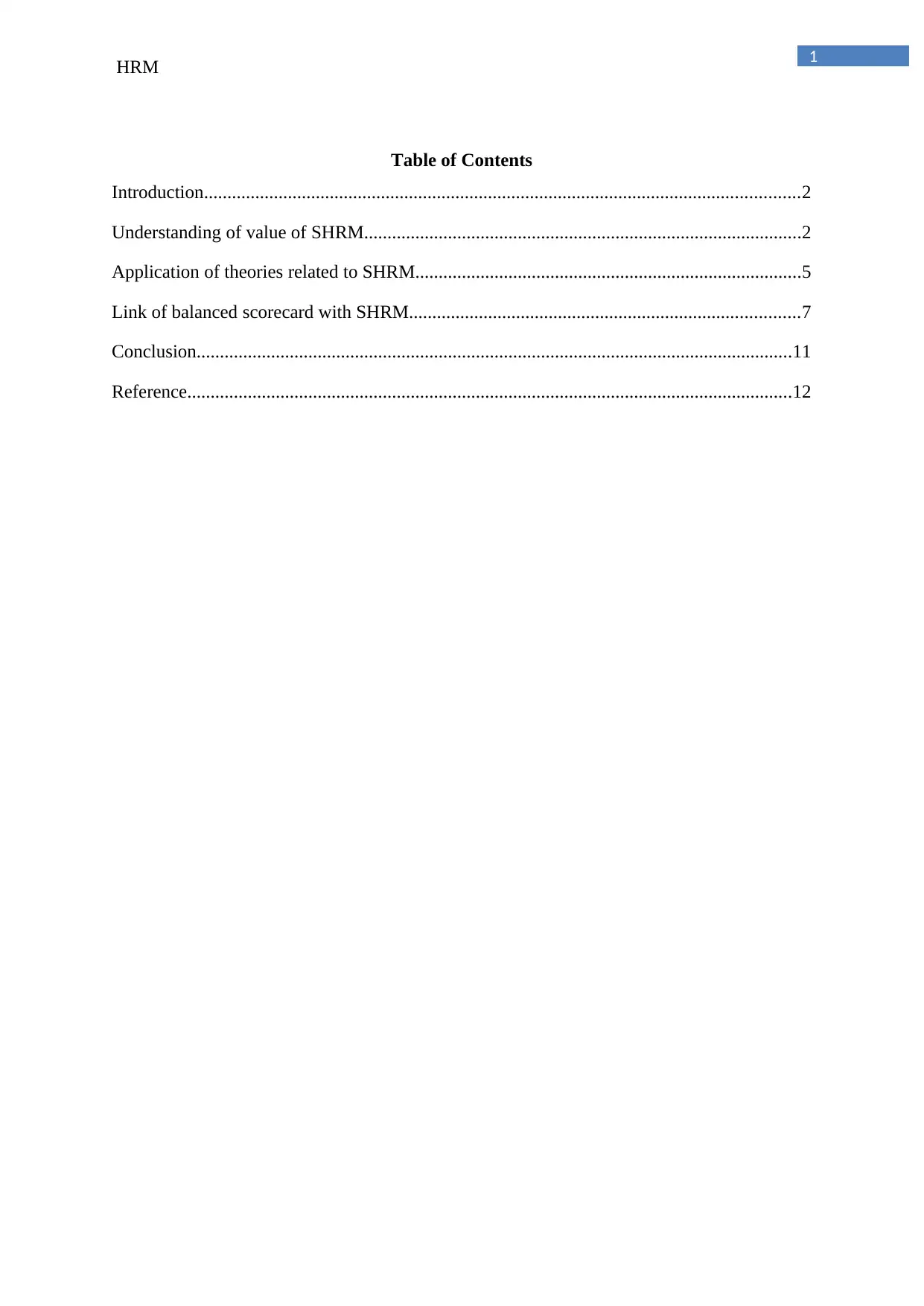
1
HRM
Table of Contents
Introduction................................................................................................................................2
Understanding of value of SHRM..............................................................................................2
Application of theories related to SHRM...................................................................................5
Link of balanced scorecard with SHRM....................................................................................7
Conclusion................................................................................................................................11
Reference..................................................................................................................................12
HRM
Table of Contents
Introduction................................................................................................................................2
Understanding of value of SHRM..............................................................................................2
Application of theories related to SHRM...................................................................................5
Link of balanced scorecard with SHRM....................................................................................7
Conclusion................................................................................................................................11
Reference..................................................................................................................................12
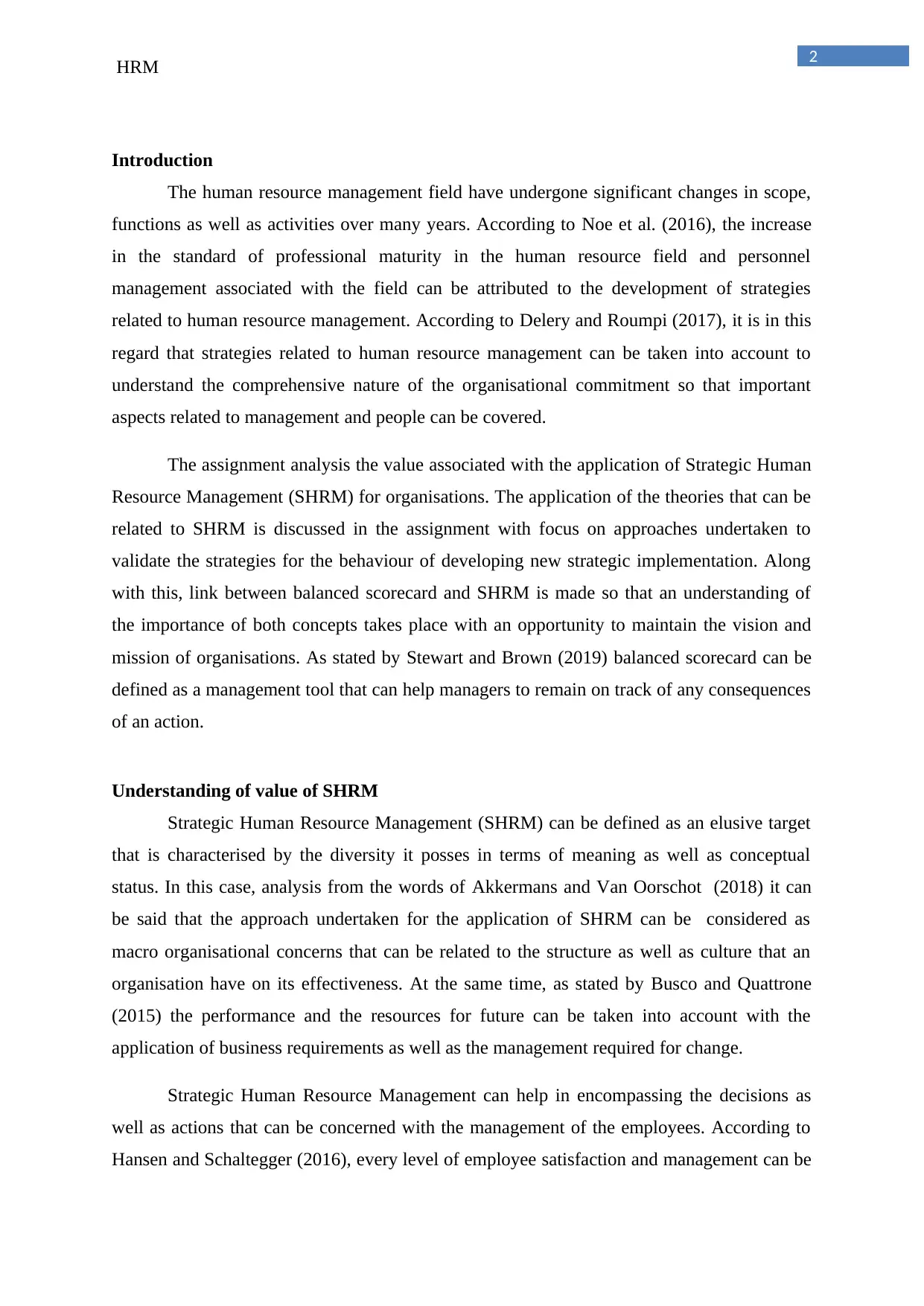
2
HRM
Introduction
The human resource management field have undergone significant changes in scope,
functions as well as activities over many years. According to Noe et al. (2016), the increase
in the standard of professional maturity in the human resource field and personnel
management associated with the field can be attributed to the development of strategies
related to human resource management. According to Delery and Roumpi (2017), it is in this
regard that strategies related to human resource management can be taken into account to
understand the comprehensive nature of the organisational commitment so that important
aspects related to management and people can be covered.
The assignment analysis the value associated with the application of Strategic Human
Resource Management (SHRM) for organisations. The application of the theories that can be
related to SHRM is discussed in the assignment with focus on approaches undertaken to
validate the strategies for the behaviour of developing new strategic implementation. Along
with this, link between balanced scorecard and SHRM is made so that an understanding of
the importance of both concepts takes place with an opportunity to maintain the vision and
mission of organisations. As stated by Stewart and Brown (2019) balanced scorecard can be
defined as a management tool that can help managers to remain on track of any consequences
of an action.
Understanding of value of SHRM
Strategic Human Resource Management (SHRM) can be defined as an elusive target
that is characterised by the diversity it posses in terms of meaning as well as conceptual
status. In this case, analysis from the words of Akkermans and Van Oorschot (2018) it can
be said that the approach undertaken for the application of SHRM can be considered as
macro organisational concerns that can be related to the structure as well as culture that an
organisation have on its effectiveness. At the same time, as stated by Busco and Quattrone
(2015) the performance and the resources for future can be taken into account with the
application of business requirements as well as the management required for change.
Strategic Human Resource Management can help in encompassing the decisions as
well as actions that can be concerned with the management of the employees. According to
Hansen and Schaltegger (2016), every level of employee satisfaction and management can be
HRM
Introduction
The human resource management field have undergone significant changes in scope,
functions as well as activities over many years. According to Noe et al. (2016), the increase
in the standard of professional maturity in the human resource field and personnel
management associated with the field can be attributed to the development of strategies
related to human resource management. According to Delery and Roumpi (2017), it is in this
regard that strategies related to human resource management can be taken into account to
understand the comprehensive nature of the organisational commitment so that important
aspects related to management and people can be covered.
The assignment analysis the value associated with the application of Strategic Human
Resource Management (SHRM) for organisations. The application of the theories that can be
related to SHRM is discussed in the assignment with focus on approaches undertaken to
validate the strategies for the behaviour of developing new strategic implementation. Along
with this, link between balanced scorecard and SHRM is made so that an understanding of
the importance of both concepts takes place with an opportunity to maintain the vision and
mission of organisations. As stated by Stewart and Brown (2019) balanced scorecard can be
defined as a management tool that can help managers to remain on track of any consequences
of an action.
Understanding of value of SHRM
Strategic Human Resource Management (SHRM) can be defined as an elusive target
that is characterised by the diversity it posses in terms of meaning as well as conceptual
status. In this case, analysis from the words of Akkermans and Van Oorschot (2018) it can
be said that the approach undertaken for the application of SHRM can be considered as
macro organisational concerns that can be related to the structure as well as culture that an
organisation have on its effectiveness. At the same time, as stated by Busco and Quattrone
(2015) the performance and the resources for future can be taken into account with the
application of business requirements as well as the management required for change.
Strategic Human Resource Management can help in encompassing the decisions as
well as actions that can be concerned with the management of the employees. According to
Hansen and Schaltegger (2016), every level of employee satisfaction and management can be
⊘ This is a preview!⊘
Do you want full access?
Subscribe today to unlock all pages.

Trusted by 1+ million students worldwide
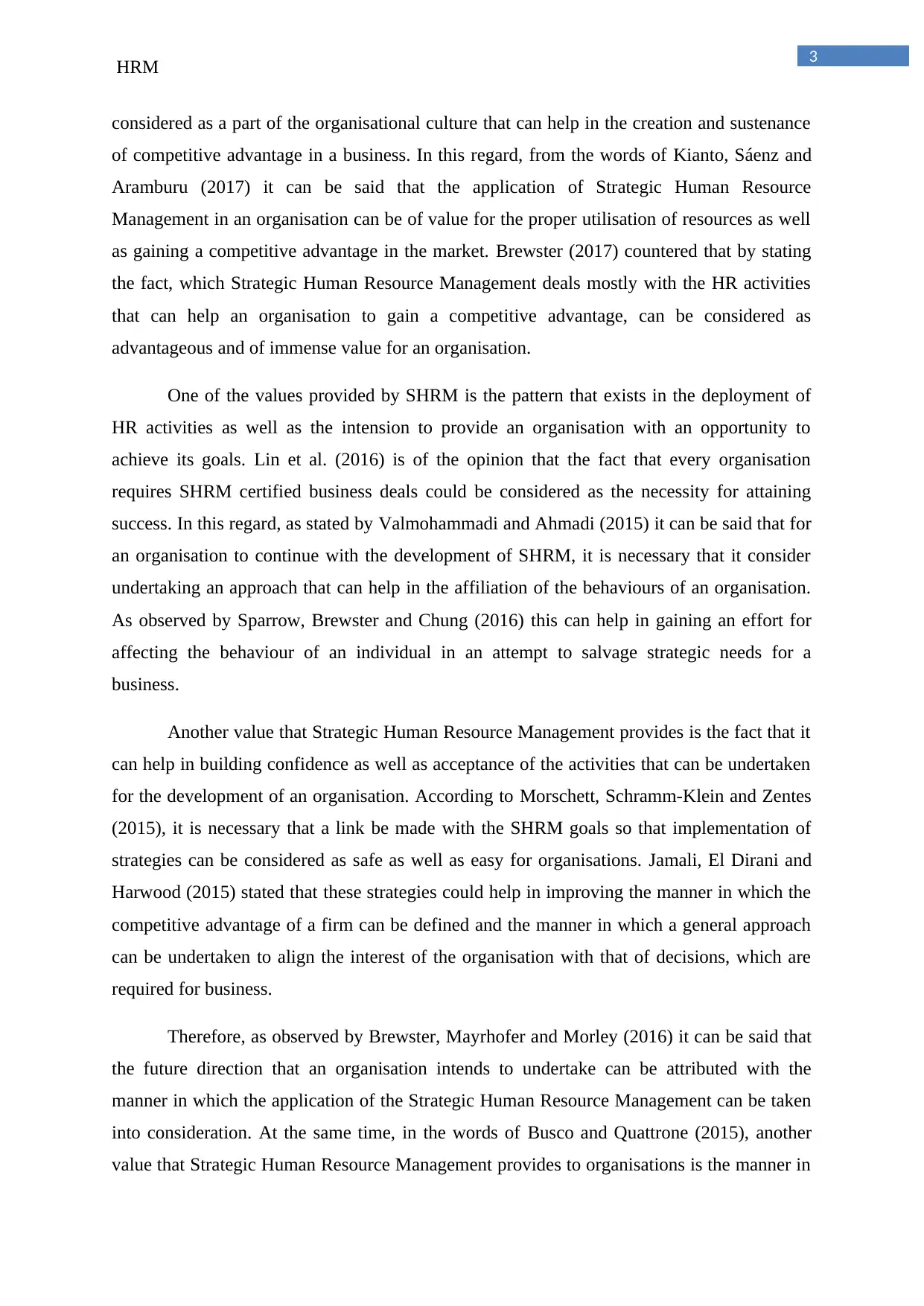
3
HRM
considered as a part of the organisational culture that can help in the creation and sustenance
of competitive advantage in a business. In this regard, from the words of Kianto, Sáenz and
Aramburu (2017) it can be said that the application of Strategic Human Resource
Management in an organisation can be of value for the proper utilisation of resources as well
as gaining a competitive advantage in the market. Brewster (2017) countered that by stating
the fact, which Strategic Human Resource Management deals mostly with the HR activities
that can help an organisation to gain a competitive advantage, can be considered as
advantageous and of immense value for an organisation.
One of the values provided by SHRM is the pattern that exists in the deployment of
HR activities as well as the intension to provide an organisation with an opportunity to
achieve its goals. Lin et al. (2016) is of the opinion that the fact that every organisation
requires SHRM certified business deals could be considered as the necessity for attaining
success. In this regard, as stated by Valmohammadi and Ahmadi (2015) it can be said that for
an organisation to continue with the development of SHRM, it is necessary that it consider
undertaking an approach that can help in the affiliation of the behaviours of an organisation.
As observed by Sparrow, Brewster and Chung (2016) this can help in gaining an effort for
affecting the behaviour of an individual in an attempt to salvage strategic needs for a
business.
Another value that Strategic Human Resource Management provides is the fact that it
can help in building confidence as well as acceptance of the activities that can be undertaken
for the development of an organisation. According to Morschett, Schramm-Klein and Zentes
(2015), it is necessary that a link be made with the SHRM goals so that implementation of
strategies can be considered as safe as well as easy for organisations. Jamali, El Dirani and
Harwood (2015) stated that these strategies could help in improving the manner in which the
competitive advantage of a firm can be defined and the manner in which a general approach
can be undertaken to align the interest of the organisation with that of decisions, which are
required for business.
Therefore, as observed by Brewster, Mayrhofer and Morley (2016) it can be said that
the future direction that an organisation intends to undertake can be attributed with the
manner in which the application of the Strategic Human Resource Management can be taken
into consideration. At the same time, in the words of Busco and Quattrone (2015), another
value that Strategic Human Resource Management provides to organisations is the manner in
HRM
considered as a part of the organisational culture that can help in the creation and sustenance
of competitive advantage in a business. In this regard, from the words of Kianto, Sáenz and
Aramburu (2017) it can be said that the application of Strategic Human Resource
Management in an organisation can be of value for the proper utilisation of resources as well
as gaining a competitive advantage in the market. Brewster (2017) countered that by stating
the fact, which Strategic Human Resource Management deals mostly with the HR activities
that can help an organisation to gain a competitive advantage, can be considered as
advantageous and of immense value for an organisation.
One of the values provided by SHRM is the pattern that exists in the deployment of
HR activities as well as the intension to provide an organisation with an opportunity to
achieve its goals. Lin et al. (2016) is of the opinion that the fact that every organisation
requires SHRM certified business deals could be considered as the necessity for attaining
success. In this regard, as stated by Valmohammadi and Ahmadi (2015) it can be said that for
an organisation to continue with the development of SHRM, it is necessary that it consider
undertaking an approach that can help in the affiliation of the behaviours of an organisation.
As observed by Sparrow, Brewster and Chung (2016) this can help in gaining an effort for
affecting the behaviour of an individual in an attempt to salvage strategic needs for a
business.
Another value that Strategic Human Resource Management provides is the fact that it
can help in building confidence as well as acceptance of the activities that can be undertaken
for the development of an organisation. According to Morschett, Schramm-Klein and Zentes
(2015), it is necessary that a link be made with the SHRM goals so that implementation of
strategies can be considered as safe as well as easy for organisations. Jamali, El Dirani and
Harwood (2015) stated that these strategies could help in improving the manner in which the
competitive advantage of a firm can be defined and the manner in which a general approach
can be undertaken to align the interest of the organisation with that of decisions, which are
required for business.
Therefore, as observed by Brewster, Mayrhofer and Morley (2016) it can be said that
the future direction that an organisation intends to undertake can be attributed with the
manner in which the application of the Strategic Human Resource Management can be taken
into consideration. At the same time, in the words of Busco and Quattrone (2015), another
value that Strategic Human Resource Management provides to organisations is the manner in
Paraphrase This Document
Need a fresh take? Get an instant paraphrase of this document with our AI Paraphraser

4
HRM
which expertise abilities as well as understanding of the values it has on an organisation can
be taken into account. According to Sparrow, Brewster and Chung (2016), these are specified
by the application of SHRM and can have a severe impact on business. The fact that Strategic
Human Resource Management is concerned with long-term people issues can be considered
for the improvement of business can be taken into consideration with its application.
Thus, SHRM can help in the development of processes, which can help in forming a
pattern required for organisational development. In this regard, from the words of
Valmohammadi and Ahmadi (2015) it can be said that the application of the process can help
in the development of managing human resources, which in turn can be useful for the
strategic SHRM deals with concerns related to the structure, value, culture as well as quality
and commitment towards an organisation. Therefore, as observed by Brewster and
Hegewisch (2017) from the analysis it can be said that another value that Strategic Human
Resource Management provides can be associated with the development of positive climate
related to employee relations.
In this regard, the aim of SHRM can be taken into consideration so that its value can
be understood in a proper manner. According to Cooper, Ezzamel and Qu (2017), Strategic
Human Resource Management helps in the generation of strategic capability that can be
based on skills commitment as well as for the motivation for the employees. This is done in
order to ensure that sustained competitive advantage is attained which can help in the
development of a business. Moreover, as observed by Brewster, Mayrhofer and Morley
(2016) based on the sense of direction the turbulent environment concerned with the business
needs can be considered as individual as well as collective requirements associated with the
employees. Therefore, in the words of Delery and Roumpi (2017), the development and
application of any practical Human Resource policies and programmes can be considered as a
value providing opportunity for organisations.
At the same time, scope of Strategic Human Resource Management can help in the
development of HR field so that delivery of new ideas can be taken into account to accelerate
the business procedure that exists in a business. In this regard, as stated by Akkermans and
Van Oorschot (2018) it can be said that stand out opportunity that can be considered for HR
applicants can be considered as a cause that helps in the acceptance rate of the employees.
Based on this analysis, the application of theories, which can be related to the development of
SHRM, can be taken into account. As pointed out by Morschett, Schramm-Klein and Zentes
HRM
which expertise abilities as well as understanding of the values it has on an organisation can
be taken into account. According to Sparrow, Brewster and Chung (2016), these are specified
by the application of SHRM and can have a severe impact on business. The fact that Strategic
Human Resource Management is concerned with long-term people issues can be considered
for the improvement of business can be taken into consideration with its application.
Thus, SHRM can help in the development of processes, which can help in forming a
pattern required for organisational development. In this regard, from the words of
Valmohammadi and Ahmadi (2015) it can be said that the application of the process can help
in the development of managing human resources, which in turn can be useful for the
strategic SHRM deals with concerns related to the structure, value, culture as well as quality
and commitment towards an organisation. Therefore, as observed by Brewster and
Hegewisch (2017) from the analysis it can be said that another value that Strategic Human
Resource Management provides can be associated with the development of positive climate
related to employee relations.
In this regard, the aim of SHRM can be taken into consideration so that its value can
be understood in a proper manner. According to Cooper, Ezzamel and Qu (2017), Strategic
Human Resource Management helps in the generation of strategic capability that can be
based on skills commitment as well as for the motivation for the employees. This is done in
order to ensure that sustained competitive advantage is attained which can help in the
development of a business. Moreover, as observed by Brewster, Mayrhofer and Morley
(2016) based on the sense of direction the turbulent environment concerned with the business
needs can be considered as individual as well as collective requirements associated with the
employees. Therefore, in the words of Delery and Roumpi (2017), the development and
application of any practical Human Resource policies and programmes can be considered as a
value providing opportunity for organisations.
At the same time, scope of Strategic Human Resource Management can help in the
development of HR field so that delivery of new ideas can be taken into account to accelerate
the business procedure that exists in a business. In this regard, as stated by Akkermans and
Van Oorschot (2018) it can be said that stand out opportunity that can be considered for HR
applicants can be considered as a cause that helps in the acceptance rate of the employees.
Based on this analysis, the application of theories, which can be related to the development of
SHRM, can be taken into account. As pointed out by Morschett, Schramm-Klein and Zentes

5
HRM
(2015) it needs to be kept in mind that Strategic Human Resource Management can help an
organisation to mitigate any type of hazards by assuring administrative compliance of
business.
Application of theories related to SHRM
In order to SHRM in a proper manner, the theories involved with it and its application
in business can be taken into consideration. According to Noe et al. (2017), one of the
essential theories that can be applied with Strategic Human Resource Management is that of
the Human Capital Theory. Stewart and Brown (2019) are of the opinion that the application
of the Human Capital Theory can allow organisations to be productive as well as remain
adaptable so that people can be treated extensively in an organisation. In the words of
Sánchez, Marín and Morales (2015), the application of the theory can be considered as
contextual factors that can help in the analysis of the market conditions, unions as well as the
competition that exists.
The application can be associated with the cost required for alternative approaches so
that SHRM can be used for the increase of value in an organisation. Hence, as stated by
Brewster (2017) the application of the Human Capital Theory can be considered as an
increase to the value of the human resources that an organisation possesses. At the same time,
from the words of Delery and Roumpi (2017) it can be said that value generated in a business
by virtue of alternate returns can be taken into consideration, which can help in the
development of organisational success. Thus, in the words of Busco and Quattrone (2015) the
application of the Human Capital Theory can be considered as effective for identifying and
implementing SHRM strategies in an organisation.
Along with the application of the Human Capital Theory, certain non-strategic as well
as cybernetic model can be taken into consideration for the smooth applicaton of Strategic
Human Resource Management in business. According to Akkermans and Van Oorschot
(2018), the application of the cybernetic model can be applied in an effective manner in an
organisational setting by analysing the concept associated with inter dependent parts. The
skills and abilities possessed by individuals working in an organisation can be seen as the
input abilities for the development of individuals. Muda et al. (2017) is of the opinion that the
application of the cybernetic model can help in the practise of various SHRM models, which
HRM
(2015) it needs to be kept in mind that Strategic Human Resource Management can help an
organisation to mitigate any type of hazards by assuring administrative compliance of
business.
Application of theories related to SHRM
In order to SHRM in a proper manner, the theories involved with it and its application
in business can be taken into consideration. According to Noe et al. (2017), one of the
essential theories that can be applied with Strategic Human Resource Management is that of
the Human Capital Theory. Stewart and Brown (2019) are of the opinion that the application
of the Human Capital Theory can allow organisations to be productive as well as remain
adaptable so that people can be treated extensively in an organisation. In the words of
Sánchez, Marín and Morales (2015), the application of the theory can be considered as
contextual factors that can help in the analysis of the market conditions, unions as well as the
competition that exists.
The application can be associated with the cost required for alternative approaches so
that SHRM can be used for the increase of value in an organisation. Hence, as stated by
Brewster (2017) the application of the Human Capital Theory can be considered as an
increase to the value of the human resources that an organisation possesses. At the same time,
from the words of Delery and Roumpi (2017) it can be said that value generated in a business
by virtue of alternate returns can be taken into consideration, which can help in the
development of organisational success. Thus, in the words of Busco and Quattrone (2015) the
application of the Human Capital Theory can be considered as effective for identifying and
implementing SHRM strategies in an organisation.
Along with the application of the Human Capital Theory, certain non-strategic as well
as cybernetic model can be taken into consideration for the smooth applicaton of Strategic
Human Resource Management in business. According to Akkermans and Van Oorschot
(2018), the application of the cybernetic model can be applied in an effective manner in an
organisational setting by analysing the concept associated with inter dependent parts. The
skills and abilities possessed by individuals working in an organisation can be seen as the
input abilities for the development of individuals. Muda et al. (2017) is of the opinion that the
application of the cybernetic model can help in the practise of various SHRM models, which
⊘ This is a preview!⊘
Do you want full access?
Subscribe today to unlock all pages.

Trusted by 1+ million students worldwide
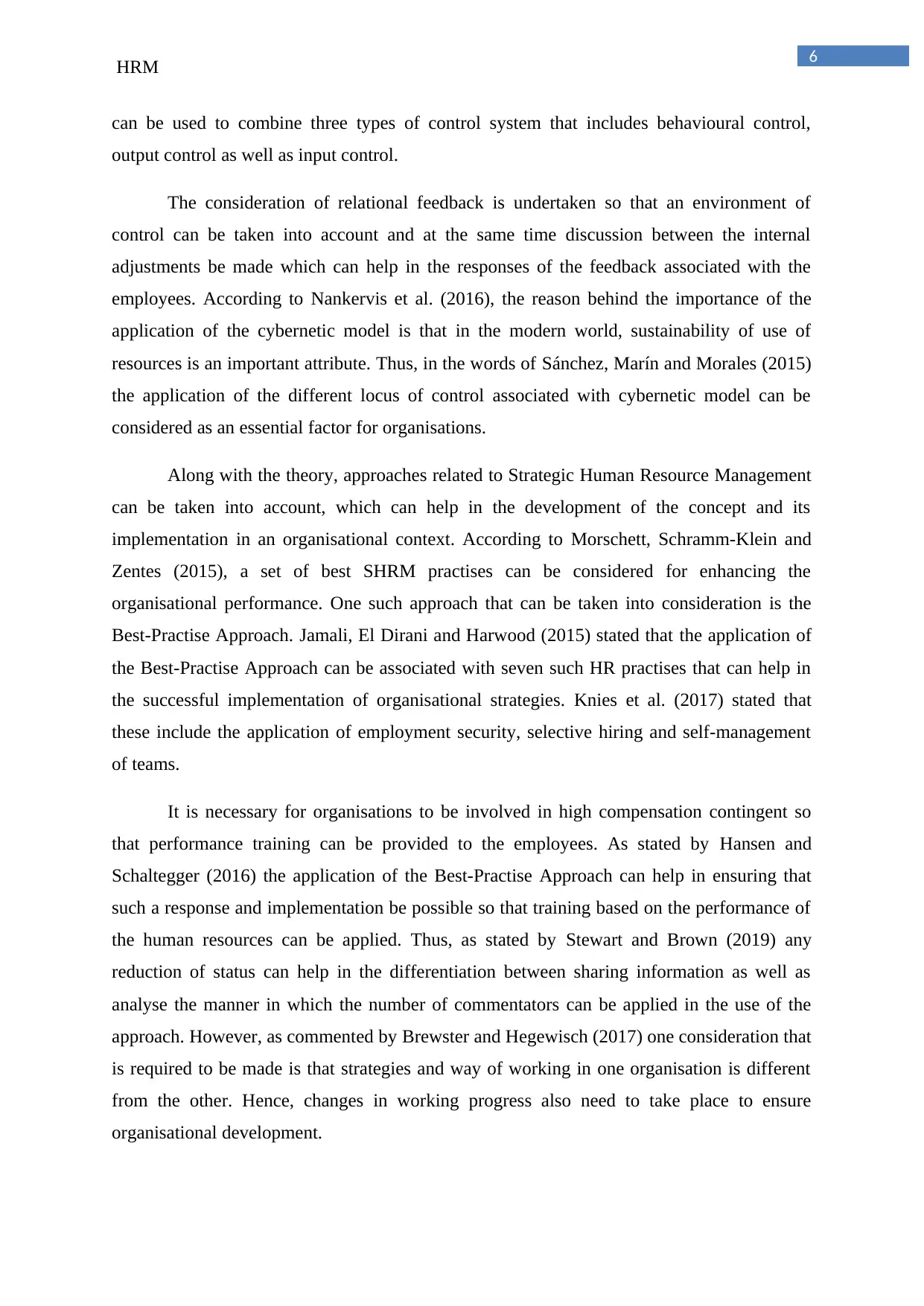
6
HRM
can be used to combine three types of control system that includes behavioural control,
output control as well as input control.
The consideration of relational feedback is undertaken so that an environment of
control can be taken into account and at the same time discussion between the internal
adjustments be made which can help in the responses of the feedback associated with the
employees. According to Nankervis et al. (2016), the reason behind the importance of the
application of the cybernetic model is that in the modern world, sustainability of use of
resources is an important attribute. Thus, in the words of Sánchez, Marín and Morales (2015)
the application of the different locus of control associated with cybernetic model can be
considered as an essential factor for organisations.
Along with the theory, approaches related to Strategic Human Resource Management
can be taken into account, which can help in the development of the concept and its
implementation in an organisational context. According to Morschett, Schramm-Klein and
Zentes (2015), a set of best SHRM practises can be considered for enhancing the
organisational performance. One such approach that can be taken into consideration is the
Best-Practise Approach. Jamali, El Dirani and Harwood (2015) stated that the application of
the Best-Practise Approach can be associated with seven such HR practises that can help in
the successful implementation of organisational strategies. Knies et al. (2017) stated that
these include the application of employment security, selective hiring and self-management
of teams.
It is necessary for organisations to be involved in high compensation contingent so
that performance training can be provided to the employees. As stated by Hansen and
Schaltegger (2016) the application of the Best-Practise Approach can help in ensuring that
such a response and implementation be possible so that training based on the performance of
the human resources can be applied. Thus, as stated by Stewart and Brown (2019) any
reduction of status can help in the differentiation between sharing information as well as
analyse the manner in which the number of commentators can be applied in the use of the
approach. However, as commented by Brewster and Hegewisch (2017) one consideration that
is required to be made is that strategies and way of working in one organisation is different
from the other. Hence, changes in working progress also need to take place to ensure
organisational development.
HRM
can be used to combine three types of control system that includes behavioural control,
output control as well as input control.
The consideration of relational feedback is undertaken so that an environment of
control can be taken into account and at the same time discussion between the internal
adjustments be made which can help in the responses of the feedback associated with the
employees. According to Nankervis et al. (2016), the reason behind the importance of the
application of the cybernetic model is that in the modern world, sustainability of use of
resources is an important attribute. Thus, in the words of Sánchez, Marín and Morales (2015)
the application of the different locus of control associated with cybernetic model can be
considered as an essential factor for organisations.
Along with the theory, approaches related to Strategic Human Resource Management
can be taken into account, which can help in the development of the concept and its
implementation in an organisational context. According to Morschett, Schramm-Klein and
Zentes (2015), a set of best SHRM practises can be considered for enhancing the
organisational performance. One such approach that can be taken into consideration is the
Best-Practise Approach. Jamali, El Dirani and Harwood (2015) stated that the application of
the Best-Practise Approach can be associated with seven such HR practises that can help in
the successful implementation of organisational strategies. Knies et al. (2017) stated that
these include the application of employment security, selective hiring and self-management
of teams.
It is necessary for organisations to be involved in high compensation contingent so
that performance training can be provided to the employees. As stated by Hansen and
Schaltegger (2016) the application of the Best-Practise Approach can help in ensuring that
such a response and implementation be possible so that training based on the performance of
the human resources can be applied. Thus, as stated by Stewart and Brown (2019) any
reduction of status can help in the differentiation between sharing information as well as
analyse the manner in which the number of commentators can be applied in the use of the
approach. However, as commented by Brewster and Hegewisch (2017) one consideration that
is required to be made is that strategies and way of working in one organisation is different
from the other. Hence, changes in working progress also need to take place to ensure
organisational development.
Paraphrase This Document
Need a fresh take? Get an instant paraphrase of this document with our AI Paraphraser

7
HRM
Link of balanced scorecard with SHRM
Balanced scorecard is a strategic planning and management system that is used in an
extensive manner in business and industries worldwide to align with business activities that
may have a comprehension over the mission and vision of the organisational performances
against any strategic goals. According to Berman et al. (2019), one of the new phases that can
be associated with balanced scorecard is the emphasis it puts on the implementation role,
which is prepared as an organisational capability. Therefore, as stated by Keyes (2016) the
link between balanced scorecard and SHRM can be identified as a key enabler for
organisational strategy execution.
The multidimensional feature of the balanced scorecard provides managers with a fast
and comprehensive view of business. As stated by Nankervis et al. (2016) the CEOs get an
opportunity to look into business based on the four important perspectives, which includes
financial perspective, customer perspective, internal process perspective and learning and
growth perspective. According to Sánchez Marín and Morales (2015), he organisational level
strategy mapping can show logical sequence with an opportunity to develop a cause and
effect relationship in business. It also helps to provide a visual framework so that integration
can be made in the strategies of an organisation. Hence, Knies et al. (2017) is of the opinion
that the importance of strategic framework can be made into a comprehensive analysis by
understanding the manner in which link can be made with the strategic forecasting for
organisational success.
Muda et al. (2017) have identified that organisations usually adopt different tools for
the development of strategies however, the validation of the strategies can be considered in
terms of gaining a perspective, which can help in establishing a cause and effect relationship
for the organisations. Thus, as stated by Cooper, Ezzamel and Qu (2017) the organisational
level balanced scorecard can be translated into operational language related with the strategic
measures and key performance indicators of the companies. The focus is to deploy every
activity that can help in causing benefits for every performance indicator. At the same time,
Brewster et al. (2016) stated that strategic alignment could be aligned with the human
resource team so that a comprehensive as well as effective organisational strategy can be
formed.
An example can be provided that can help to understand the relation between the
strategic human resource management with that of the team.
HRM
Link of balanced scorecard with SHRM
Balanced scorecard is a strategic planning and management system that is used in an
extensive manner in business and industries worldwide to align with business activities that
may have a comprehension over the mission and vision of the organisational performances
against any strategic goals. According to Berman et al. (2019), one of the new phases that can
be associated with balanced scorecard is the emphasis it puts on the implementation role,
which is prepared as an organisational capability. Therefore, as stated by Keyes (2016) the
link between balanced scorecard and SHRM can be identified as a key enabler for
organisational strategy execution.
The multidimensional feature of the balanced scorecard provides managers with a fast
and comprehensive view of business. As stated by Nankervis et al. (2016) the CEOs get an
opportunity to look into business based on the four important perspectives, which includes
financial perspective, customer perspective, internal process perspective and learning and
growth perspective. According to Sánchez Marín and Morales (2015), he organisational level
strategy mapping can show logical sequence with an opportunity to develop a cause and
effect relationship in business. It also helps to provide a visual framework so that integration
can be made in the strategies of an organisation. Hence, Knies et al. (2017) is of the opinion
that the importance of strategic framework can be made into a comprehensive analysis by
understanding the manner in which link can be made with the strategic forecasting for
organisational success.
Muda et al. (2017) have identified that organisations usually adopt different tools for
the development of strategies however, the validation of the strategies can be considered in
terms of gaining a perspective, which can help in establishing a cause and effect relationship
for the organisations. Thus, as stated by Cooper, Ezzamel and Qu (2017) the organisational
level balanced scorecard can be translated into operational language related with the strategic
measures and key performance indicators of the companies. The focus is to deploy every
activity that can help in causing benefits for every performance indicator. At the same time,
Brewster et al. (2016) stated that strategic alignment could be aligned with the human
resource team so that a comprehensive as well as effective organisational strategy can be
formed.
An example can be provided that can help to understand the relation between the
strategic human resource management with that of the team.

8
HRM
Organisational strategy employment in HR
Organisational
strategy
HR strategy Chief HR KPI HR manager KPI
Entering into
new market and
increase in sales
Developing new
marketing team
Recruitment of
marketing
executives
Cycle time for the recruitment
of marketing team
Recruitment of marketing
executives
Training to enhance
marketing
enhancement skill
Training marketing teams on
new product development
Training on
communication/presentation
skills
Designing new
policies for
marketing team
Designing incentive
scheme for the
marketing team
List of marketing executives
capable of receiving
incentives
Incentive amount that has
been paid to the marketing
team
Developing HR
policies for
International
marketing
Marketing executives covered
under the international market
Incentive amount paid to
international marketing team
Table 1: Organisational strategy employment in HR
(Source: Collings, Wood & Szamosi, 2018)
Taking into consideration this work, an organisation can align its marketing strategies.
The typical alignment made by an organisation with respect to the organisational strategy
already formed is provided in the following table.
HRM
Organisational strategy employment in HR
Organisational
strategy
HR strategy Chief HR KPI HR manager KPI
Entering into
new market and
increase in sales
Developing new
marketing team
Recruitment of
marketing
executives
Cycle time for the recruitment
of marketing team
Recruitment of marketing
executives
Training to enhance
marketing
enhancement skill
Training marketing teams on
new product development
Training on
communication/presentation
skills
Designing new
policies for
marketing team
Designing incentive
scheme for the
marketing team
List of marketing executives
capable of receiving
incentives
Incentive amount that has
been paid to the marketing
team
Developing HR
policies for
International
marketing
Marketing executives covered
under the international market
Incentive amount paid to
international marketing team
Table 1: Organisational strategy employment in HR
(Source: Collings, Wood & Szamosi, 2018)
Taking into consideration this work, an organisation can align its marketing strategies.
The typical alignment made by an organisation with respect to the organisational strategy
already formed is provided in the following table.
⊘ This is a preview!⊘
Do you want full access?
Subscribe today to unlock all pages.

Trusted by 1+ million students worldwide
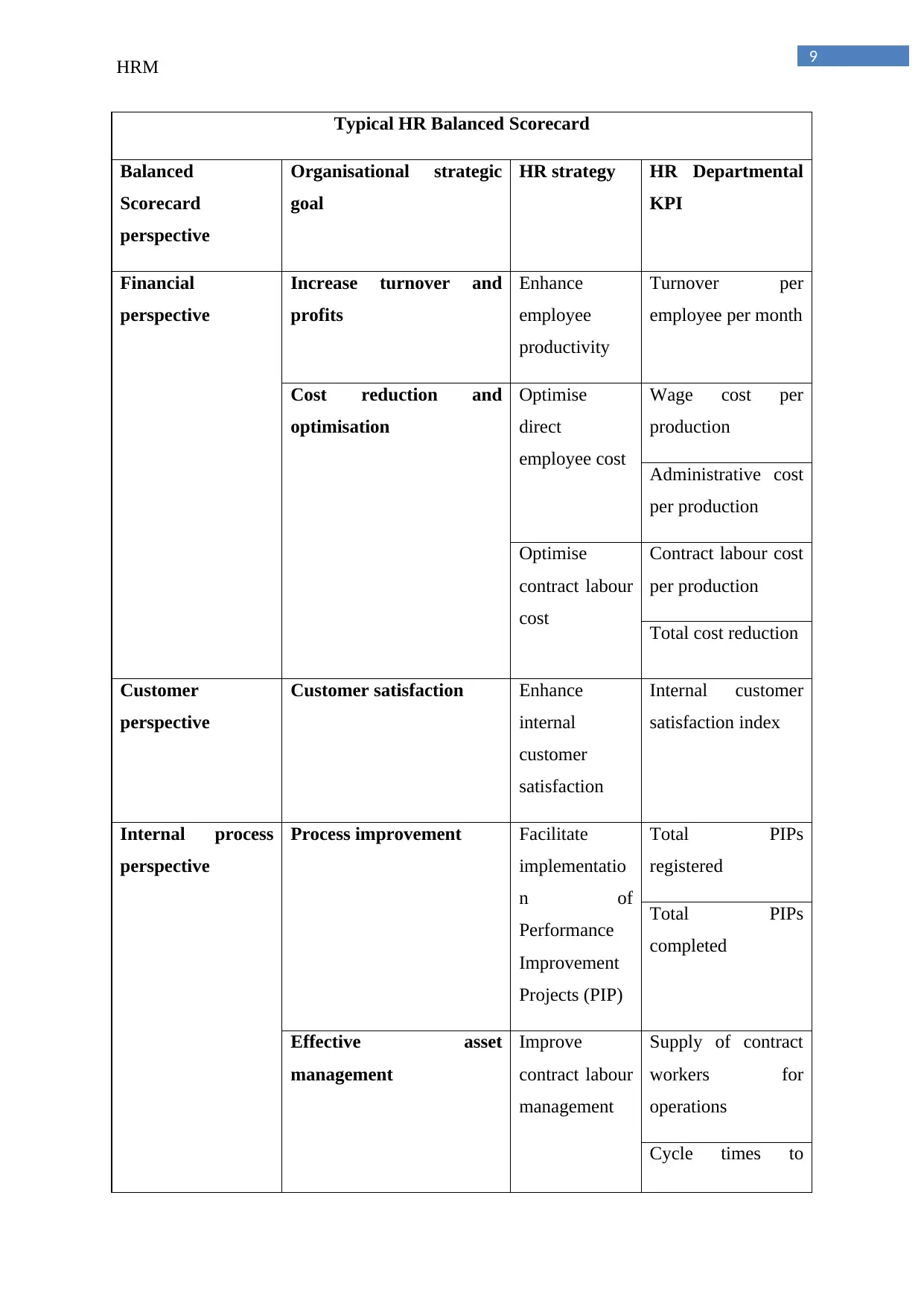
9
HRM
Typical HR Balanced Scorecard
Balanced
Scorecard
perspective
Organisational strategic
goal
HR strategy HR Departmental
KPI
Financial
perspective
Increase turnover and
profits
Enhance
employee
productivity
Turnover per
employee per month
Cost reduction and
optimisation
Optimise
direct
employee cost
Wage cost per
production
Administrative cost
per production
Optimise
contract labour
cost
Contract labour cost
per production
Total cost reduction
Customer
perspective
Customer satisfaction Enhance
internal
customer
satisfaction
Internal customer
satisfaction index
Internal process
perspective
Process improvement Facilitate
implementatio
n of
Performance
Improvement
Projects (PIP)
Total PIPs
registered
Total PIPs
completed
Effective asset
management
Improve
contract labour
management
Supply of contract
workers for
operations
Cycle times to
HRM
Typical HR Balanced Scorecard
Balanced
Scorecard
perspective
Organisational strategic
goal
HR strategy HR Departmental
KPI
Financial
perspective
Increase turnover and
profits
Enhance
employee
productivity
Turnover per
employee per month
Cost reduction and
optimisation
Optimise
direct
employee cost
Wage cost per
production
Administrative cost
per production
Optimise
contract labour
cost
Contract labour cost
per production
Total cost reduction
Customer
perspective
Customer satisfaction Enhance
internal
customer
satisfaction
Internal customer
satisfaction index
Internal process
perspective
Process improvement Facilitate
implementatio
n of
Performance
Improvement
Projects (PIP)
Total PIPs
registered
Total PIPs
completed
Effective asset
management
Improve
contract labour
management
Supply of contract
workers for
operations
Cycle times to
Paraphrase This Document
Need a fresh take? Get an instant paraphrase of this document with our AI Paraphraser
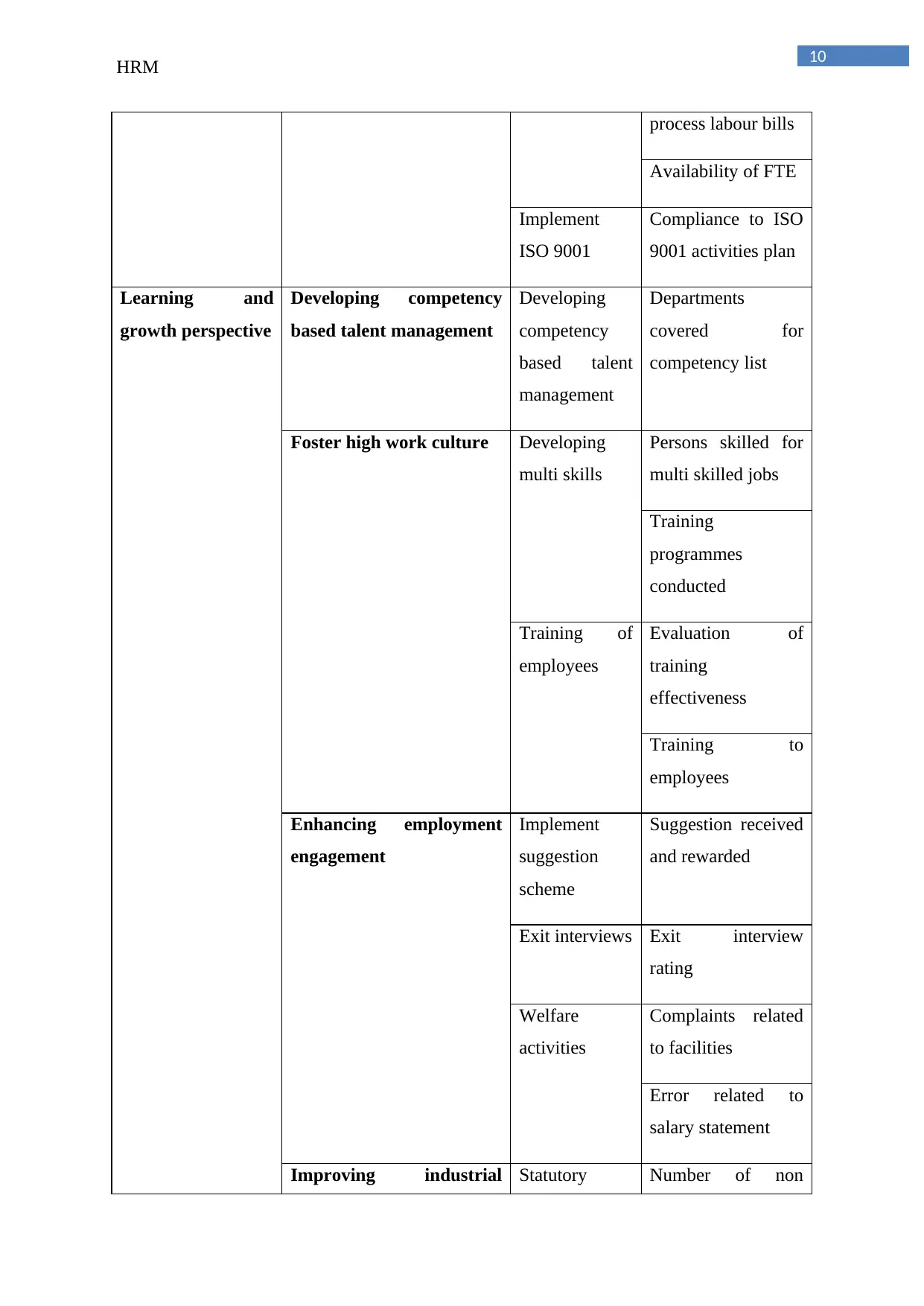
10
HRM
process labour bills
Availability of FTE
Implement
ISO 9001
Compliance to ISO
9001 activities plan
Learning and
growth perspective
Developing competency
based talent management
Developing
competency
based talent
management
Departments
covered for
competency list
Foster high work culture Developing
multi skills
Persons skilled for
multi skilled jobs
Training
programmes
conducted
Training of
employees
Evaluation of
training
effectiveness
Training to
employees
Enhancing employment
engagement
Implement
suggestion
scheme
Suggestion received
and rewarded
Exit interviews Exit interview
rating
Welfare
activities
Complaints related
to facilities
Error related to
salary statement
Improving industrial Statutory Number of non
HRM
process labour bills
Availability of FTE
Implement
ISO 9001
Compliance to ISO
9001 activities plan
Learning and
growth perspective
Developing competency
based talent management
Developing
competency
based talent
management
Departments
covered for
competency list
Foster high work culture Developing
multi skills
Persons skilled for
multi skilled jobs
Training
programmes
conducted
Training of
employees
Evaluation of
training
effectiveness
Training to
employees
Enhancing employment
engagement
Implement
suggestion
scheme
Suggestion received
and rewarded
Exit interviews Exit interview
rating
Welfare
activities
Complaints related
to facilities
Error related to
salary statement
Improving industrial Statutory Number of non
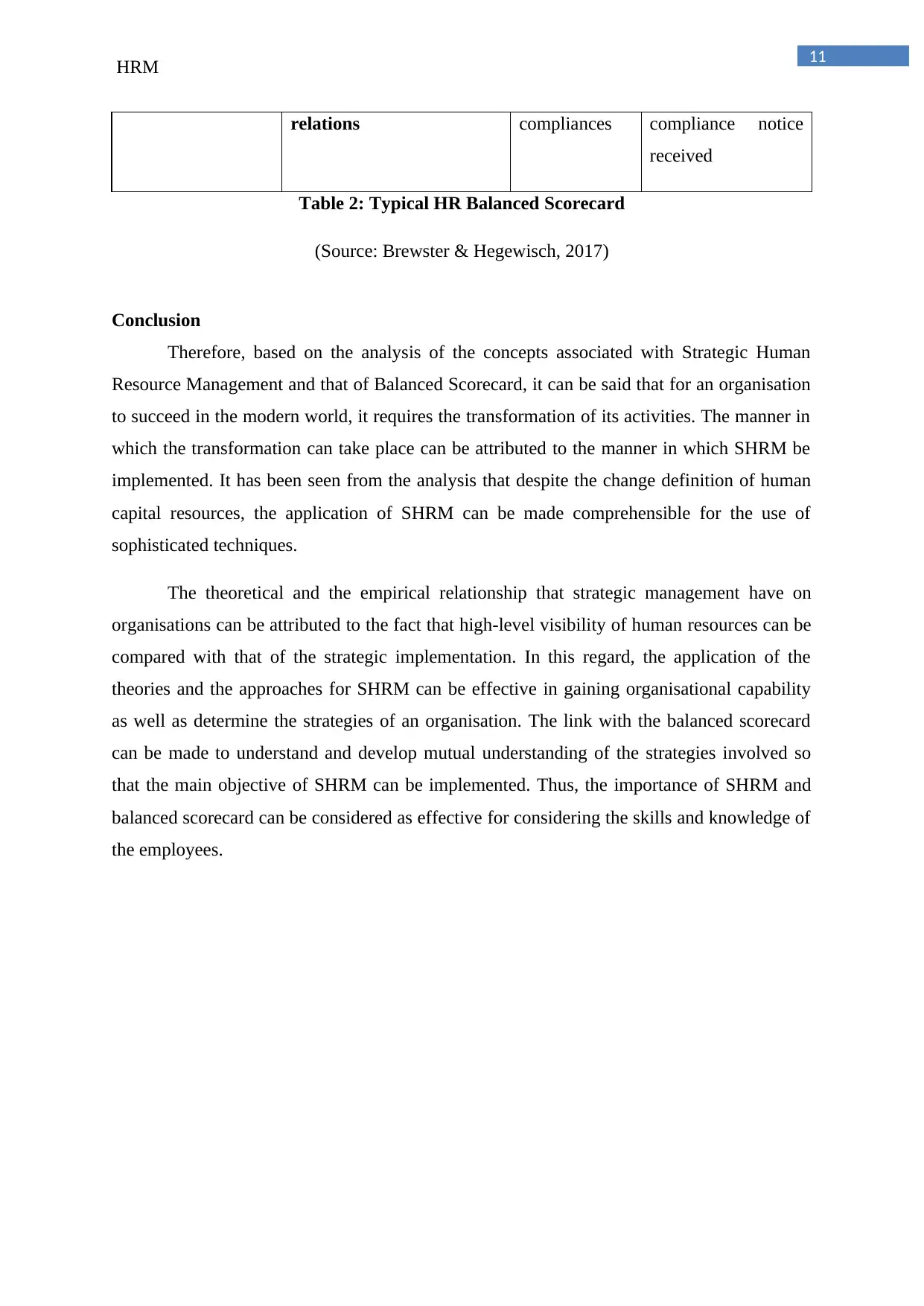
11
HRM
relations compliances compliance notice
received
Table 2: Typical HR Balanced Scorecard
(Source: Brewster & Hegewisch, 2017)
Conclusion
Therefore, based on the analysis of the concepts associated with Strategic Human
Resource Management and that of Balanced Scorecard, it can be said that for an organisation
to succeed in the modern world, it requires the transformation of its activities. The manner in
which the transformation can take place can be attributed to the manner in which SHRM be
implemented. It has been seen from the analysis that despite the change definition of human
capital resources, the application of SHRM can be made comprehensible for the use of
sophisticated techniques.
The theoretical and the empirical relationship that strategic management have on
organisations can be attributed to the fact that high-level visibility of human resources can be
compared with that of the strategic implementation. In this regard, the application of the
theories and the approaches for SHRM can be effective in gaining organisational capability
as well as determine the strategies of an organisation. The link with the balanced scorecard
can be made to understand and develop mutual understanding of the strategies involved so
that the main objective of SHRM can be implemented. Thus, the importance of SHRM and
balanced scorecard can be considered as effective for considering the skills and knowledge of
the employees.
HRM
relations compliances compliance notice
received
Table 2: Typical HR Balanced Scorecard
(Source: Brewster & Hegewisch, 2017)
Conclusion
Therefore, based on the analysis of the concepts associated with Strategic Human
Resource Management and that of Balanced Scorecard, it can be said that for an organisation
to succeed in the modern world, it requires the transformation of its activities. The manner in
which the transformation can take place can be attributed to the manner in which SHRM be
implemented. It has been seen from the analysis that despite the change definition of human
capital resources, the application of SHRM can be made comprehensible for the use of
sophisticated techniques.
The theoretical and the empirical relationship that strategic management have on
organisations can be attributed to the fact that high-level visibility of human resources can be
compared with that of the strategic implementation. In this regard, the application of the
theories and the approaches for SHRM can be effective in gaining organisational capability
as well as determine the strategies of an organisation. The link with the balanced scorecard
can be made to understand and develop mutual understanding of the strategies involved so
that the main objective of SHRM can be implemented. Thus, the importance of SHRM and
balanced scorecard can be considered as effective for considering the skills and knowledge of
the employees.
⊘ This is a preview!⊘
Do you want full access?
Subscribe today to unlock all pages.

Trusted by 1+ million students worldwide
1 out of 15
Related Documents
Your All-in-One AI-Powered Toolkit for Academic Success.
+13062052269
info@desklib.com
Available 24*7 on WhatsApp / Email
![[object Object]](/_next/static/media/star-bottom.7253800d.svg)
Unlock your academic potential
Copyright © 2020–2025 A2Z Services. All Rights Reserved. Developed and managed by ZUCOL.





